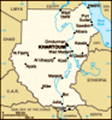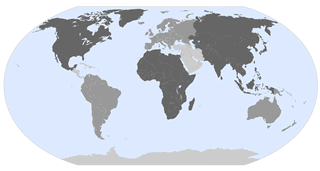Advertisement
Published: March 15th 2012
Travel within Sudan is never a straightforward endeavor. For one, the distances between points A and B are often vast, with little but desolate desert between. More of an issue, as a khawaja (foreigner), is that you must procure a travel permit – EACH time you travel away from Khartoum, specifying which part of the country you are going. And then there’s the limited tourist “infrastructure” once you get to point B – your, ahem, choice of hotels, for example, may be two tops. Which in turn means you often end up having to pay an exorbitant price for not so fantastic accommodations. There’s no real possibility of bargaining. Where else are you going to go, huh?
So I have not done as much domestic travel in Sudan as I would have liked over the course of my two-year stint in Khartoum. It has simply been easier, often cheaper, to travel abroad. However, as I approach the end of my contract in late May, it has hit me how much more I want to see before I depart; who knows when, or if, I will be back?
***
The “most-see” for me was the Red Sea coast -
and specifically the ancient port of Suakin (about which I have written a separate blog entry at:
http://akhawajainkhartoum.blogspot.com/2012/03/ottoman-elegy.html). I decided that, before the summer heat became too brutal, I would take a long weekend, busing my way there in order to see something of the northern Sudanese landscape and flying back (even if that meant risking my life on Sudan Airways!).
While my application for a travel permit was being processed, I headed down to Khartoum’s Land Terminal, a bizarre conglomerate of bus stations that are bunched together, yet disconnected. Moreover, the bus companies’ offices are tucked into the neighborhood surrounding the terminal, hidden between regular shops; it becomes something of a scavenger hunt to track down the appropriate company for your desired destination. When I walked into the dusty office of PerfectA (I loved the emphatic A), I think I caused great amusement: Who was this crazy khawaja who had come on his own to buy a ticket? Apparently, this was not an everyday occurrence.
On Friday, with my ticket in hand, I arrived bright and early (well, not bright, as dawn was just breaking!) to navigate my way into the proper segment of the Land Terminal.
You buy a token for 1.5 SDG from a vendor outside, hand the token over to the gate keeper, and then muscle your way through the crowds to the actual bus station, where you then try to pick out the right bus (in my case, the only indication of which bus was mine was a handwritten Arabic notice on a small piece of paper taped to the windshield – “PerfectA to Port Sudan”).
However, I was pleasantly surprised by the bus itself. While not luxurious, it seemed to be in good order and clean, and I could actually fit my legs into the seat without having to turn into a pretzel – unlike my experience on the taxi-brousses in Madagascar a few months ago! Also, mercifully unlike Madagascar, the seats were assigned…without extra passengers, or chickens, crammed into the aisle. We even left promptly at the appointed hour, 6:30am!
I had never been further north of Khartoum than the Meroe Pyramids (see:
http://www.travelblog.org/Africa/blog-579868.html), so when I saw them slip by I pressed my face against the window… Other than the bit of urbanity we saw passing through the town of Atbara and the glimmer of moisture offered by
the trickle of the Atbara River, the view was mostly a humbling expanse of flat desert. Not a soul in sight.
And when we ran into a billowing haboob, the scene grew even eerier: the horizon disappeared, the sky turning the same red and yellow of the desert plane. We were encompassed in a 3D version of the desert.
As if taking note of the new territory we were approaching at about hour 9, the haboob dissipated and the returning blue skies framed a distant row of coastal mountains. We stopped at the first real town that we’d seen in five hours, a lonely outpost called Sinkat. The only place, it turned out, where was asked to show my hard won travel permit – by a barefoot guy holding court next to a water tank! I didn’t dare ask: “Who are you?” In Sudan, you just hand over the permit…
Shortly after crossing through the mountains, I saw a large white ship mirage into view on the near horizon – the Jeddah ferry at Suakin. We had finally reached the Red Sea.
***
This wasn’t my first visit to the Red Sea. I’ve been to
its shores in Egypt, Jordan*, and, most recently, Saudi Arabia. But it took almost two years since landing in Khartoum for me to make it to the Sudanese shore…
For reasons that might be obvious, Sudan does not have the same kind of developed seaside tourism as you can find in its northern neighbor. There’s no equivalent to Egypt’s Sharm el-Sheik in Sudan. Which is part of the appeal. If you have the money and the means, the diving off of Sudan is supposedly some of the very best in the Red Sea – unspoiled nature and seas completely untrammeled by tourists.
However, the flip side: where does one stay? Port Sudan is by far the most developed town on the coast – but it is a mercantile hub, not a tourist center. One of the only hotels in town offers rooms at a breathtaking $250 per night (who are the guests?!), but it’s smack dab in the middle of town – not on the sea. Almost all the expats I know who’ve ventured to Port Sudan elect to stay at the grandly named Sudan Red Sea Resort, which sometimes describes itself as an “ecolodge”. It offers accommodation
at a slightly more reasonable rate of 250 SDG per night with full board, but at the official exchange rate that’s still almost $100 a night. And this is for a simple, partially open-air hut with saggy beds.
It’s also in a rather odd location about 30km north of Port Sudan. The “resort” is built on a barren coral-based “island” separated from the shore by a wide mudflat. There’s also no real beach on the seashore. The water level is less than a foot for a considerable distance, out to the edge of the first coral reef (and that shallow layer of water covers a layer of squishy mud, not sand).
Admittedly, the resort offers a few distinct advantages. Being built on an exposed bit of land surrounded mostly by the sea, it catches the cooling breezes off the water. The weather was markedly cooler and more comfortable at the resort than in the sultry town centers of both Port Sudan and Suakin (the humidity is a shock coming from the bone-dry interior!). For this reason, it is a popular day trip for locals seeking respite from the heat. The resort also offers, via its dive center, perhaps
the region’s best access to the gorgeous coral reefs just off shore.
Although I wasn’t able, much to my deep disappointment, to afford a full diving trip, I did hire the boat to go snorkeling. Even a short distance from the resort the sea life that schooled around the reef was astounding. I saw some of the most colorful fish I have ever seen, as well as my first giant clams, their huge purple mouths pulsating amidst the coral.
I am also pretty sure I saw a shark in the distance…. But with thoughts of last year’s attack in Sharm, I decided it would be prudent not to investigate further….
***
Other than snorkeling and exploring the ruins of Suakin, I spent much of the rest of the weekend simply relaxing and reading in one of the shaded pavilions, sipping sweet cups of strong coffee. A welcome change of pace from the urban “bustle” of Khartoum.
But all good things come to an end, and it was time to return to the capital. I had made the decision not to take the bus back. I just couldn’t stomach another 11-hour return trip, especially one following
the exact same route as I used to get to the Red Sea. So I threw caution to the wind and bought a ticket on Sudan Airways.
Now, Sudan Airways is the national carrier, obviously. But almost everyone I know avoids taking it at all costs, due to its less than stellar record. Actually, when I first arrived in Sudan, the carcass of an Airbus A310 that crashed at Khartoum International in 2008 rested ominously near the edge of the airport, in full view of highway traffic. Not the greatest advertising for the airline: the charred fuselage still displaying the company name. And then last year a small aircraft landed without landing gear – though this time with out the loss of life. Part of the problem is that Sudan Airways can’t always get the parts it needs to repair its aging fleet, due to the sanctions imposed on the country.
For international flights, I would never consider flying Sudan Airways, but the domestic options are much more limited. So I took a deep breath (and prayed), as I boarded the plane at the tiny Port Sudan airport.
Much to my relief, I was in one of
the newer planes, and all went well. We left on time, the flight was smooth, they served drinks and a snack (on an hour long flight – an unheard of degree service compared to the US!)... All went well. I think I even let out an audible gasp of relief when I heard the landing gear unfurl during our descent.
My weekend escape to the Red Sea was officially at an end.
* I feel like I should be able to count Israel, as I could look into its Red Sea resort town of Eilat from Jordan’s Aqaba. Actually, from the boat I took from Aqaba, I could see the shores of Jordan, Israel, Egypt, and Saudi all at once!
Advertisement
Tot: 0.123s; Tpl: 0.013s; cc: 12; qc: 29; dbt: 0.074s; 1; m:domysql w:travelblog (10.17.0.13); sld: 1;
; mem: 1.1mb






















